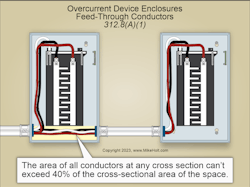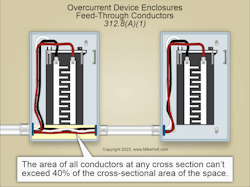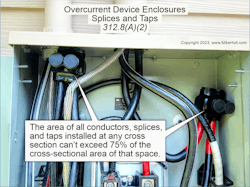Courtesy of www.MikeHolt.com
All questions and answers are based on the 2023 NEC.
Q. What are the NEC requirements related to cabinets for panelboards related to repairing gaps in noncombustible surfaces?
A. The requirements related to cabinets for panelboards associated with repairing gaps in noncombustible surfaces are found in Sec. 312.4. Recessed cabinets for panelboards and cutout boxes in noncombustible surfaces (plaster, drywall, or plasterboard) must not have a gap of more than 1⁄8 in. around any edge of the cabinet.
Q. Does the NEC permit splices, taps, and feed-through conductors in panelboards?
A. Yes, Sec. 312.8(A) permits splices, taps, and feed-through conductors in panelboards.
The wiring space within cabinets for panelboards can be used for conductors feeding through, spliced, or tapped where all the conditions of (1), (2), and (3) are met:
(1) The area of all conductors at any cross section does not exceed 40% of the cross-sectional area of that space (Fig. 1).
(2) The area of all conductors, splices, and taps installed at any cross section does not exceed 75% of the cross-sectional area of that space (Fig. 2).
Author’s Comment: The 40% and 75% requirements apply to all conductors, splices, and taps within the cross-sectional area, not just conductors, splice(s), or tap(s) being added.
(3) The bending space for conductors 4 AWG and larger complies with 314.28(A)(2).
(4) Where conductors feed through the cabinet, a permanently affixed warning label sufficiently durable to withstand the environment involved, and complying with 110.21(B), must be applied on the cabinet to identify the location of the disconnect for the feed-through conductors.
These materials are provided to us by Mike Holt Enterprises in Leesburg, Fla. To view Code training materials offered by this company, visit www.mikeholt.com/code.
About the Author

Mike Holt
Mike Holt is the owner of Mike Holt Enterprises (www.MikeHolt.com), one of the largest electrical publishers in the United States. He earned a master's degree in the Business Administration Program (MBA) from the University of Miami. He earned his reputation as a National Electrical Code (NEC) expert by working his way up through the electrical trade. Formally a construction editor for two different trade publications, Mike started his career as an apprentice electrician and eventually became a master electrician, an electrical inspector, a contractor, and an educator. Mike has taught more than 1,000 classes on 30 different electrical-related subjects — ranging from alarm installations to exam preparation and voltage drop calculations. He continues to produce seminars, videos, books, and online training for the trade as well as contribute monthly Code content to EC&M magazine.



